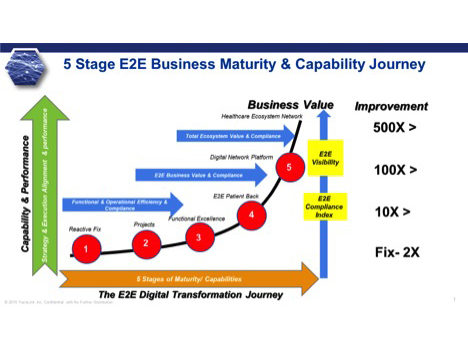
(Editors’ note: This is the third of a five-part series of articles about the journey to creating an end-to-end business network that enables demand-driven supply capabilities.)
How do companies manage the arduous journey of end-to-end digital transformation, while keeping the business operating?
For leading organizations, the answer is adoption of the five-stage maturity and capability model, originally developed at AMR Research and continuing to be researched by Gartner.
The five-stage framework is used by leaders to diagnose the state of current business and supply-chain capabilities (including work practices, processes, people, and technologies); plan transformative change, and report progress to the larger business.
The maturity model codifies the steps that a company needs to take to evolve from a linear and reactive supply chain to the advanced orchestration of key capabilities (described as “Stage 5+”). In that final stage, the supply chain becomes part of an extended partner network, as in the case of the end-to-end life sciences and healthcare ecosystem.
The five-stage model is an extremely useful tool for leading and managing change, if deployed systematically. It provides a framework to:
- Describe pertinent industry trends in a staged manner,
- Describe, assess, and diagnose the state of a business’s capabilities,
- Provide a roadmap to plot the journey to a specific industry or business vision,
- Answer specific questions based on best and practices, metrics, and benchmarks in the current stage of a company’s capabilities,
- Identify specific challenges within the current stage of capability,
- Articulate practices that represent “what good looks like,” as well as identify potential pitfalls and constraints,
- Outline and benchmark best practices and opportunities for organizations (for example, within the life sciences networked ecosystem),
- Track the status of, and make recommendations on, the company’s stage of capability,
- Support decision-making and project prioritization as the company evolves the technology and digital-transformation roadmap, and
- Support the organization’s evolution, talent pool, and operating model as the journey to a networked partner ecosystem progresses.
The model is a change-management framework for developing leadership and business practices, as companies mature from linear point-to-point businesses to multidimensional network platforms of players. It offers a valuable roadmap for coalescing people, process and technology elements into a digitally based supply-chain networked ecosystem.
Next: The 5+ Stage Maturity Model
Roddy Martin is Chief Digital Strategist with TraceLink.







